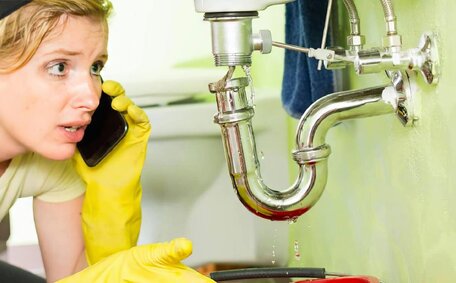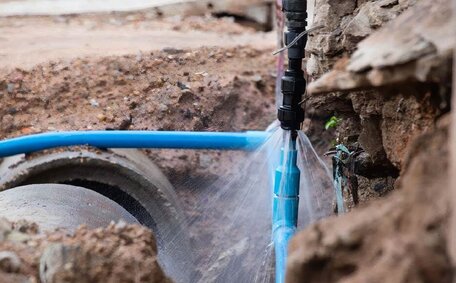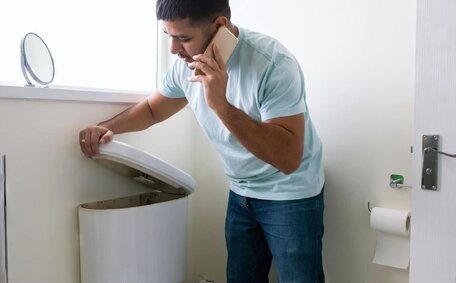Introduction to Pipe Relining
Maintaining your plumbing system is crucial for preventing leaks, bursts, and blockages. When broken pipes become damaged over time, sewer pipe relining offers an efficient and long-lasting repair solution. This trenchless method is crucial for preserving existing pipes in your sewer system, being less invasive than traditional pipe replacement and conserving time, funds while safeguarding against significant property damage.
When considering relining vs pipe replacement, Northmead Plumbing’s approach to relining involves inserting a resin liner into the existing pipe to create a new pipe within an old one.
To discover more about our effective and affordable pipe relining solutions, contact Northmead Plumbing. We are dedicated to restoring your plumbing’s integrity with the latest trenchless technology, revolutionising the way we approach pipe repair in Sydney.
Why Pipe Relining is Necessary
There are multiple reasons why pipes get damaged, indicating the need for relining.
Pipes inevitably deteriorate due to prolonged usage and aging.
The age of pipes significantly influences durability; for instance, older cast iron drains tend to corrode and accumulate mineral deposits that block water flow. In areas like the eastern suburbs, PVC, concrete, and clay pipes may crack or break due to ground movement and pressure. Tree root interference is a notorious problem, and while root cutting offers temporary relief, relining delivers a permanent fix with a robust internal barrier.
Trenchless relining is a preferable alternative to disruptive excavation, as it forms a new pipe inside the old one seamlessly, showcasing the cost-effectiveness of the process.
How Pipe Relining Works
Cured-in-place piping (CIPP), or no-dig pipe relining, repairs pipes trenchlessly without excavation. Below is an overview of the pipe relining process:
- First, the plumber will use a CCTV camera to inspect the inside of your pipe and determine if it’s suitable for relining. This allows them to see any cracks, leaks or blockages.
- The pipe is then thoroughly cleaned to remove any built-up deposits or intruding roots. High-pressure water jets are efficient solutions for clearing blocked drains, and you’ll want to use them again for routine maintenance.
- A felt liner soaked in epoxy resin is inserted into the damaged pipe through an access point like a manhole. The liner coats the inner walls, sealing cracks and filling gaps.
- During the relining pipe procedure, The liner does pipe reinforcement as it is inflated against the pipe walls and cured using hot water, steam or UV light. This hardens the resin into a smooth, seamless new pipe.
- Once cured, the liner is trimmed at entry and exit points. Service laterals are also reinstated if disconnected during the process.
- Finally, the pipe is CCTV inspected again to ensure the relining was successful. The result is an impenetrable epoxy barrier preventing further damage.
Pipe relining provides more than just a repair; it conserves your landscaping and prevents property damage without the need to dig up your yard. The impact on your property is minimal, with processes that can take as little as 1-2 days to conclude. Get ready, set to experience improved plumbing, and speak to our team at Northmead Plumbing to learn more about trenchless pipe relining.
Factors That Influence Relining Costs
The cost between pipe relining options can vary significantly depending on several key factors:
- Pipe diameter and length - Larger and longer pipes necessitate extra relining materials and longer installation times, leading to higher costs.
- Access - Limited access to pipes through cleanouts or entry points may require additional excavation to begin the relining, which adds expense.
- Relining technique - Steam-inflated CIPP liners typically cost more compared to those cured with UV light.
- Number of junctions - The more joints, bends and branches in the pipeline, the more complex the project and greater the cost.
- Location - Pipe accessibility, local labour rates and other variables related to your location can impact price.
- Materials - More durable or specialised resin materials and liners are typically more costly.
- Work schedule - Emergency repairs or off-hours work usually costs more given the additional labour burden.
- Associated risks - Complicated projects or hazardous site conditions may carry added expenses.
To understand the cost of your pipe relining job, contact our team at Northmead Plumbing for a detailed quote. We will thoroughly inspect your pipes and propose the most cost-effective solution.
Pipe Size and Length
Smaller diameter drain pipe reline for kitchen and bathroom drains may have a cost of $150-300 per linear metre on average. For medium 6-8 inch sewer pipes, the query on how much does sewer pipe relining solutions depend on numerous factors, with expenses averaging approximately $200-350 per metre. Larger 10-15 inch main pipes’ relining is typically priced at $250-500+ per foot.
material calculations, Longer pipe work often involves greater effort accessing, cleaning and installing the liner.
A longer pipeline may also indicate a more complex layout with multiple bends, joins and branches that add labour time. Get in touch with our team at Northmead Plumbing for an accurate quote accounting for the specific size and length of your pipes.
Access to the Pipes
The ease with which pipes can be accessed affects relining costs, since complex access adds to the expenses for equipment, labour, and materials.
If pipes are easily accessed through cleanouts, manholes or other entry points, costs may be lower. However, pipes located under landscaping, structures or concrete may require excavation to open access.
If access to pipes is limited, our technicians may spend more time threading the liner into position and using inspection cameras to manoeuvre around bends. Creating access points in hard-to-reach areas may involve strategic digging.
At Northmead Plumbing, our plumbing services utilise advanced pipe relining techniques and tools to gain access with minimal property damage. However, restricted access invariably incurs greater costs overall. Allow us to carry out an inspection of your pipes and advise the best repair approach based on accessibility, as well as pipe layout and condition.
Relining Method
There are a few different methods that can be used for pipe relining, which can vary in cost and suitability depending on the job:
- Inversion relining: This is the most common method, involving inverting a resin-soaked liner into the damaged pipe and curing it with hot water or steam. Costs around $150-550 per metre.
- UV light relining: A UV light-cured liner is blown or pulled into the pipe and hardened with UV radiation. Usually cheaper than inversion at $100-450 per metre.
- Patch relining: Used for repairing short, isolated sections of damage rather than full lengths. Individual patches are inserted and expanded into place. Costs from $250 per patch.
Factors like pipe length, access and junctions will still affect costs for any method. Our technicians at Northmead Plumbing will inspect your pipes and propose the ideal relining method with a transparent quote for your job.
Number of Junctions
The number of junctions, bends, branches and connections in the pipeline can impact the cost of relining. More junctions increase material expenses since extra resin and liner length is required at each junction.
Junctions also add complexity for installing the liner, requiring more preparation and skill to reline each intersecting section smoothly. Allowing the liner to cure properly is more difficult around bends and junctions too.
As a rough estimate, each additional junction could add $50-150 to the project cost, a calculation made evident when comparing between pipe sections. A long pipeline with multiple junctions and branches may cost 20-30% more than a straight pipe relining. Our team will inspect your pipe layout and propose an accurate quote accounting for the number of junctions needing repair.
Location and Site Conditions
The location of the plumbing system and the specific conditions on site can influence the scope of a pipe relining job and the associated costs. Pipes located underneath landscaped yards, patios, driveways or other built structures often require more preparation and repair work to access the pipes prior to relining.
On the other hand, in urban areas, relining may be more complex and expensive due to navigating around existing infrastructure and buildings. Rural jobs typically have easier pipe access but may incur travel costs for equipment and technicians to reach remote locations.
Local labour costs, material access, and permit demands can also affect the final price. Site-specific issues like problematic drainage, tree roots, rocky terrain, and high groundwater levels contribute to complexity and additional costs.
Our team at Northmead Plumbing performs an on-site evaluation of the location and conditions to provide an accurate pipe relining cost Sydney quote, ensuring our customers receive both excellent service and value. We hold our customers’ satisfaction paramount, using advanced techniques that can overcome access issues while keeping costs reasonable. Contact us to learn more about how site specifics can influence your pipe relining costs.
Materials Used
The materials used in pipe relining are a key factor affecting the overall cost. The resin and felt or fibreglass liner make up the bulk of material expenses. Higher quality epoxy resins and reinforced liners last longer but can be more expensive.
Standard polyester or vinylester resins offer adequate durability at a lower upfront cost. Epoxy resins are more resistant to corrosion, abrasion and chemicals, providing enhanced longevity and often worth the extra investment. Similarly, reinforced liners with layers of felt, fibreglass or carbon fibre hold up better over time.
We use top-grade materials from reputable brands to ensure optimal performance and lifespan for your pipe relining solutions. While quality materials have a higher initial cost, they greatly reduce the risk of repairs or replacement in the future. Choosing the right relining products for your specific pipes can save you considerable expense in the long-term.
Contact the team at Northmead Plumbing to discover how cost pipe relining material options can enhance your project. We will propose a solution using high-quality products that provide lasting results while keeping your budget in mind.
Similarly, reinforcing products for your specific pipes gives you long-term value for money.
Benefits of Pipe Relining
Pipe relining offers numerous benefits compared to traditional pipe replacement methods:
- Enhanced pipe strength and longevity - The epoxy resin liner strengthens damaged pipes for decades of further use.
- Pipe relining cost on average is 50% less than pipe replacement.
- Versatile application - It works on a wide range of pipe materials and sizes.
- Lasting solution - Relined pipes come with long-term guarantees against leaks, bursting or roots.
For an efficient and non-invasive pipe repair, give us an opportunity to discuss the end cost, recognising how pipe relining stands as the preferred solution. Contact the team at Northmead Plumbing to learn more about the benefits pipe relining offers for your damaged pipes.
Relining Techniques and Costs
There are two primary methods for relining damaged pipes: inversion relining and cured-in-place pipe (CIPP) lining. Each has its own advantages and costs per metre.
Inversion relining involves saturating a resin-impregnated felt liner and inverting it into the pipe through an access point. The resin lining process is meticulously carried out with the liner being inflated and the resin cured using hot water or steam to solidify. Inversion relining involves saturating a resin-impregnated felt liner and inverting it into the pipe through an access point.
On average, inversion relining costs $250-500 per metre depending on pipe size.
CIPP lining is a similar process, and one might ask how much does the relining cost with a felt or fibreglass liner saturated with UV-curable resin. The liner is pulled or blown into place then cured with UV lamps rather than hot water. CIPP tends to be used more for smaller pipes in residential property and costs around $150-350 per metre on average.
At the end of the day, ensuring that a licensed plumber is chosen to reline your pipes with the appropriate technique is pivotal for cost-efficiency. Our licenced plumbers will assess your unique situation and recommend the ideal relining method with a competitive quote for maximal durability. Contact us today to learn more about the trenchless relining process.
Getting an Accurate Cost Estimate
Obtaining an accurate pipe relining quote involves learning about pipe conditions through the right questions and an on-site inspection by your plumber.
Key questions to ask include:
- What type and size pipes need relining (e.g. 6 inch sewer)?
- What is the how many meters pipe requiring repair?
- How accessible are the damaged sections of pipe?
- How many bends, joints or junctions are there along the run?
- Have you identified any other complicating factors?
An experienced plumber will also need to thoroughly assess your pipe needs on-site using CCTV cameras. This visual inspection clarifies your pipe’s needs by ascertaining the condition, length, diameter, and the quantity of junctions. It also reveals any issues with pipe accessibility or risky conditions that could impact the work.
With accurate details from your inspection, we provide transparent quotes detailing the final cost projections. We also discuss the best relining method and materials for long-term results. Contact our team at Northmead Plumbing to schedule your pipe assessment and discover what does pipe relining cost with no obligation quote.
Questions to Ask Your Plumber
When setting up your inquiries for pipe relining quotes, be sure to ask your plumber these key questions:
- What experience do you have with pipe relining jobs?
- Will you use CCTV cameras to thoroughly inspect my pipes first?
- What relining method do you recommend for my situation and why?
- What type of resin materials will be used?
- How long is the cure time and when can I resume using my plumbing system?
- How long is the warranty on materials and workmanship?
- Do you provide written quotes detailing all projected costs?
- Will you obtain the necessary permits for pipe relining?
- Can I see photos of some pipe relining projects you’ve completed?
A reputable provider of pipe relining services should be willing to answer all of your questions. Make sure you call us to clarify the full scope of work and all associated costs before agreeing to move forward. Performing due diligence helps ensure you receive quality pipe relining service.
Ways to Reduce Relining Costs
There are a few ways homeowners can potentially reduce the costs of a pipe relining project:
- Opt for a UV-cured liner rather than hot water inversion lining - The curing method is faster and uses less equipment.
- Have the work done during off-peak times - Scheduling on weekdays or in cooler months can mean savings.
- Combine interior drain relining with main sewer line repairs - Bundling works often lowers costs.
- Use coupon codes or look for special offers from reputable contractors.
- Consider slightly thinner liners for branch pipes and non-pressurised lines.
- Discuss options to use more affordable resin materials that still provide adequate durability.
- Request a discount for agreeing to let the company display a small sign in your yard.
While some cost-saving measures may be tempting, never compromise on professional workmanship or quality brands. Prioritise an optimal balance of affordability and quality by choosing a reputable contractor like Northmead Plumbing.
Additional Expenses to Expect
Beyond the core costs of materials and labour for the relining work itself, there are a few additional expenses that may apply to your project:
- Permit fees - Your local council may require plumbing permits for pipe relining which typically cost $150-300.
- Access restoration - Repairs to walls, floors or landscaping if access points were created to reach pipes.
- Pipe cleaning - High pressure jet cleaning prior to relining may cost $100-200 depending on pipe length.
- Junction sealing - Relining also involves sealing off pipe junctions with a polymer resin to isolate the section being relined, which can add $50-150 per junction.
- Emergency plumbing callout - Urgent repairs due to pipe failure prior to relining may involve extra fees.
- Warranty - Opting for an extended warranty on materials and workmanship is recommended but adds cost.
Be sure to clarify any additional charges with your plumber when obtaining a pipe relining quote. While extra expenses apply in some cases, a well-executed relining project still represents excellent value compared to full pipe replacement.
The Value of Investing in Relining
Investing in pipe relining offers great long-term value compared to other pipe repair methods and may prevent extensive damage where you’d end up requiring significant repair work. Relining can extend the life of damaged pipes by 50 years or more, while being a faster, less invasive and more cost-effective solution than pipe replacement.
Our relining method creates a durable epoxy barrier that effectively prevents deterioration, restores flow efficiency, and stops leaks, bursts, and blockages. This ensures your pipes are fortified to endure pressure, erosion, and root invasion.
Although relining incurs a higher initial cost compared to temporary solutions like pipe patching, it offers a significant return on investment by providing reliable performance for decades. Compared to the costs of constant repairs or complete replacements, relining provides substantial long-term value.
Conclusion
When it comes to restoring your damaged pipes, pipe relining best serves homeowners as the choice for a cost-effective and minimally disruptive solution. While costs vary based on pipe specifics, relining ultimately offers greater value than repeated repairs or full replacement by extending your plumbing lifespan 50 years or more.
By electing to give us a chance to inspect your pipelines thoroughly, you’re securing a stellar relining outcome, with transparent quotes. Investing in high-quality materials and professional installation can help give you peace of mind that your system is structurally reinforced.
Our experts will factor in the size pipe when calculating the cost of your pipe relining, ensuring we find the right option for your budget.
Don’t let the threat of leaks, blockages, and pipe failures concern you. Reach out to Northmead Plumbing for peace of mind. We can assess and budget your pipe relining project, guaranteeing efficient water flow and dependable plumbing for the future.






